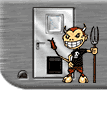





 |
 |
 |
||
 |
 |
 |
||
|
|
|
|
|
|
| Home : Behavioralist Module : Assignment 3 | |||||||||||
Behavior Change ContractTo complete this assignment successfully, you should:
Assignment: Develop a behavior change contract on a student. An easy way to complete this objective is to read about behavior contracting in the text. Hyman, the author of your text, gives a slightly different name to the behavior change contract. He calls it Behavioral Diagnosis. He describes the set of steps and necessary procedures on pp. 50 - 63 in the text. Please review that material and then proceed.
Most behaviors are linked to situations in the environment and needs or drives that the student feels. They become behavior problems when they come in conflict with the needs of the teacher or the behaviors and actions of other students. If you are student oriented, this analysis is the next step in helping a student find a better way to gain need satisfaction. If you are content oriented, this is the next step in getting the classroom order reestablished and students back under control and on task. (Which of the two orientations do you think fits the behaviorist philosophy of education and describes the teaching role?) Steps in Making a Behavior Contract:
You may choose Case One which comes out of your Hyman book and is a fairly simple case (p. 37), or take on a more difficult challenge and try Case Two. Case One: Chris is an eleven year old boy in the sixth grade. He lives with his natural mom, step dad, new sister, age 1. The familyās income is considered middle class, both parents work at blue collar jobs. The parents divorce occurred during Chrisās kindergarten year at school. He was in a regular kindergarten, moved to from kindergarten to transitional 1st grade, then on to a regular 1st grade. His behavior in kindergarten and first grade was restless, clingy, dependent, and sometime oppositional. In the second grade the earlier behaviors disappeared, and were replaced with more appropriate, grade level skills; able to do work, did well in some areas "when he wanted to," periodically misbehaved, When misbehavior occurred the teacher had trouble getting him to attend to work, daydreamed. Reports show that this behavior remained consistent through 6th grade. In the sixth grade he became very disruptive- inconsistent in following directions, out of seat, talking out of turn, making aggressive statement and gestures toward other students, when asked to sit down or stop bothering them. He never physically attacks his peers, but his behavior is erratic. By afternoon, Chris spends very little time at seat work compared with his peers. The teacher believes that Chris is not learning much in class, although he is able to pass tests when he studies for them during class time.
Jerome is an eleven year old fifth grade student. He is of an average size, and weight. He was retained last year due to his lack of retention and absenteeism. Jerome lives with his mother, older brother, and younger sister. His father is not present at this time, but continues to move in and out of the childās life. The home life isnāt a stable one, and the family continues to move around the community a lot. The mother has stated that there were no problems during pregnancy or delivery. During a student interview, Jerome stated he would rather spend time with adults or older students, and that he enjoys riding and working on his motorcycle. His mother reaffirmed his statement during the parent interview. Jerome has a learning disability plus has been diagnosed with ADHD. He is currently not taking medication since the Ritalin he was taking gave him migraine headaches. He is in the average to low average intelligence range and performs his academic work below his intelligence range. Jerome has problems controlling his anger, and keeping his hands to himself. He has also been heard saying obscene remarks about women to the young girls in his class. Many times he does this when no one is listening or he thinks no one is listening. He has stated, during a student interview, that the children tease him and this teasing makes him angry. Jerome acts out in class by drawing attention to himself and away from the teacher. He makes loud noises that disturbs the rest of the class, refuses to do assigned work, typically ignores the teacherās requests, and sometimes even gets under the tables to gain attention. Jeromeās teachers and other staff members have requested help. Problems Identified:
Belief systems addressed by Jerome's home room teacher: Biophysical: Diagnosis of ADHD by physician, needs to return to The doctor and have medication changed to something he can take That won't give him migraine headaches. Treatment options - rule out organic problems and prescribe medications that do not cause headaches. Behavioral/Cognitive-Behavioral: ADHD causes impulsivity, Aggression toward peers, especially girls seems to be reinforced and action is increasing; refusal to work is reinforced by teacher reaction and the students appear to give muted approval, even when acting scandalized, Arrived at through classroom observations, checklists, behavior records from classroom. Treatment options - Behavior contract, Behavior charts, Develop an intermittent reward system for acceptable behaviors, Teach appropriate behaviors such as anger management, time on task. Ecological: Difficulty working or associating around others, seems to have more difficulty when not supervised, even has problems at home sleeping at night, and resting well÷could be caused by ADHD. The anger is more evident at school, according to the mother, and is triggered when others tease him and this upsets him, Arrived at by use of parent interview, student interview, and observation. Treatment options - Enhance communication skills, change seating in classrooms if problem, encourage learning in personal strengths, work to build a stronger learning community and support the student learning to get along better with peers and gain approval for positive behaviors. Humanistic: Seems to search for approval and security in a relationship, very mature thinking, seems distrustful of peers and others, wants and enjoys success, needs more goal orientation, Arrived at through peer interviews, student interview, parent interview, and observation of student. Treatment options - Increase trust in relationships, build friendship with student especially a man, build a stronger sense of self by recognizing student strengths in front of other students, provide grade-level work, help student to learn self-control. Psychodynamic: Seems to not have any serious developmental delays, actually has very logical thinking, and seems emotionally mature..this may even be part of the problem since others arenāt as mature about things and seem childish to him, therefore making him angry. Arrived at through interviews, case history from parents, observation in classroom. Treatment options - Use logical consequences and discuss responsibilities and expectations, provide experiences that allow for some measure of success, help student feel more empowered by helping him set and work toward realistic goals, give student a chance to show independence and responsibility, psychotherapy on at least a weekly basis.
SUGGESTED
READING Follow each of the steps in defining your case study and developing a behavior change plan.
There are many plans available on the Internet, too. Click here to go to a site that gives more than 50 interventions for working with students who are ADD or ADHD, and this is a great article on social skills enhancement for students with LD .
The
seven step plan was used to analyze a student behavior or set of behaviors.
|
|||||||||||
| E-mail J'Anne Ellsworth at Janne.Ellsworth@nau.edu | |||||||||||
|
Course Created by J'Anne Ellsworth & Center for Technology Enhanced Learning Copyright
© 2001 Northern Arizona University |
|||||||||||
 |
 |
 |
 |
 |
|